Menus
- Small charter for business class
- Discovery
- In the saddle
- In the city
- Motorway and expressways
- Departmental
- Part-cycle
- Braking
- Comfort / Duo
- Consumption
- Conclusion
- Colors
Small charter for business class
Suzuki finally presents its small displacement machine, announced at the 2011 Paris Motor Show. The 250 Inazuma is now launched in the dynamic segment of light motorcycles. It thus joins the Kawasaki Ninja 250, KTM Duke 200 and other Honda CBR 250. Like these competitors, the Inazuma aims to be an accessible motorcycle, both economically and in terms of handling. Without forgetting to be rewarding. Its primary target would be users looking for an inexpensive vehicle and young A2 drivers. But Suzuki also hopes to win over riders returning to the handlebars after years of abstinence. Originally designed for emerging markets, the little Suz ‘has however assets to try to convince Europe.
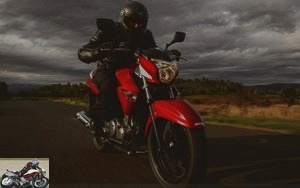
Discovery
Faced with its playmates with a sporty look, the Hamamatsu firm, to stand out, opposes a more classic roadster. Without being sad, far from it. Thus, the aesthetic codes retained for the Inazuma refer to the outrageous B-King. Considerably calm, the features are however recognizable, especially in the frontal optics. Its complex and angular shapes support the instruments and cover a 37 mm diameter fork devoid of adjustment. This is framed by the large shoulder of the side scoops, integrating the indicators, the elegantly sheathed interior of which returns to the steering column. Here again, we can feel the bodybuilt influence of the brand’s mega roadster.
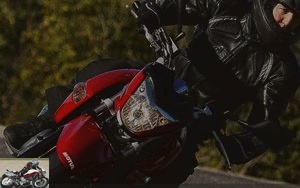
Flanked by these large protruding appendages, the tank is rounder. On this curve rests the welcoming two-seater saddle supported by a tapered rear shell. Its design is widening, supporting at its end the aluminum warhead of a passenger handle and a good size light. Likewise, the mud flap and front mudguard should be effective given their size. Their strong visual presence testifies to a desire to ensure the Inazuma 250 a stature greater than that of its engine capacity..
Obviously more discreet, the engine block heals its line. Its housings thus present dynamic and rather harmonious lines. Suzuki has designed a parallel twin cylinder of 248 cm3 wedged at 180 °, single camshaft and a bore x stroke ratio of 53.5 mm x 55.2 mm. These latter values ensure superior approval in the low and medium revs, in accordance with an advantageous use studied for the city. The twin also has a balance shaft to limit vibrations and an injection to the latest standard. Its pulsations are collected by a two-in-one-to-two line. Stainless steel manifolds bring the gases to a small plenum chamber which redistributes them in very successful chrome silencers. These small flutes are adorned with a side protection plate and dress their end with rather chic anthracite tips.
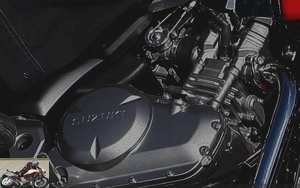
Three quarterback, made him flirtatious, mimicking the machines of the 70s.
To support the Inazuma 250, the development team chose a classic double-cradle steel frame with a bolted lower part. A tubular diamond type element would have been more attractive…. An oscillating arm of the same metal of rectangular section is attached to it. Its movements are damped by a Kayaba mono-shock absorber adjustable in preload to seven values. Easy to adjust, it is accessed by lifting the saddle. The latter reveals a small storage space, just allowing you to take a small U-shaped lock. Battery and fuses are also placed there. Finally, braking is provided by a double-piston front caliper gripping a 240 mm disc. The single piston rear retarder clamps a 180 mm element. These Nissin systems are mounted on 17 ” three-spoke aluminum wheels, tinted black.
The overall finish of the Inazuma 250 is particularly rewarding. Its generous and contrasting volumes flatter a neat plastic. Silver covers embellish its sides, mimicking a dummy GSR 600 frame, while the side fairings dress their surface with energizing streaks. Note also the driver and passenger footrest plates. Massive and decorated with a perforated aluminum plate for the first ones, discreet and coated in a shiny black for the seconds. Likewise, the style of the turn signals harmonizes with the playful line of the little Suzuki. And to perfect its elegance, many chrome come to enrich its dress. Cylinder head cover, cooling system pipes and silencer complete a successful seduction exercise.
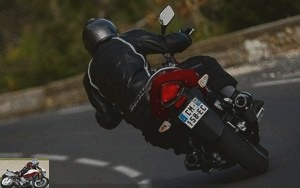
We will note all the same ugly hoses on the left side and a large space between cylinder and frames revealing some wires and other less graceful pipes..
In the saddle
Particularly accessible for people over one meter sixty five, the Inazuma 250 offers a seat only 780 mm from the ground. As envisioned, its saddle turns out to be thin and comfortable with thick padding. The position leaves the bust straight, almost too much, the legs resting on the footrests, in line with the pelvis. When stopped, the less grown-ups may be hampered by this arrangement hitting the calves. However, rider and passenger have sheathed footrests and reasonable leg flexion. Welcoming, the machine nicely accommodates my eighty-four meter. The same goes for the possible companion who will firmly ensure its maintenance via the large handle available.
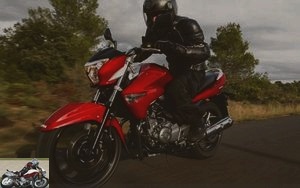
This geometry makes the hands fall naturally, not on a simple hanger, but on nicely designed half-handlebars. Attached to an upper tee of the same invoice, they overhang the large instrument panel. Particularly complete, the dashboard consists of a large central tachometer, a digital screen on the right, classic warning lights on the left and two indicator lights. The LCD window displays tachometer, clock, fuel gauge and successively: two partials, a totalizer as well as the countdown before the next service. In its upper corner, encircled by the central counter, is also a gear engaged indicator light as well as the shiftlight selection state. The latter allows you to adapt your driving in two ways. "Eco" is supposed to limit consumption as low as possible. The indicator light then illuminates at 4500 revolutions. The "normal" mode activates it 3,500 revolutions higher. You can also deactivate the system. Purely indicative, this device in no way limits the engine speed.
In practical terms, the mirrors, specific to the Inazuma 250, offer a wide field of vision and easy adjustment. We will also appreciate a brake lever adjustable in spacing Finally, two handles, located under the rear shell, will effectively secure luggage or objects transported.
In the city
The Suzuki quarter-liter comes to life discreetly, with a metallic noise. No miracle on the soundtrack side for this type of displacement, at low revs. The Inazuma 250 sets off quietly and quickly shows great agility on urban axes. Well balanced, it gives the lie to its technical sheet announcing 183 kg dry (more than 200 in running order). Its IRC Road Winner tire mount in 110 mm front and 140 mm at the rear, effectively supports the cycle part. These envelopes also equip the competition, but are here made in Japan and not in Thailand.
The Suz ‘is particularly at ease in town, easily placing itself in traffic. Its short turning radius contributes to its ease. Roundabouts, small streets, interfile, one evolves naturally on its handlebars, especially as its small engine block displays a very appreciable flexibility. Resuming on the last report at less than 2000 revolutions for 20 km / h, its smoothness will please every day. Supported by a soft and precise gearbox, the muffled mechanics also demonstrate good health, leading the crew serenely..

Motorway and expressways
With its red zone starting at 11,000 laps, the twin 250 offers significant reach and a top speed of 150 km / h. As long as you lie down on the machine and pick up the last graduations of the tachometer. More generally, the pocket Inazuma easily reaches legal speed, whirring at 9,500 laps. On board, vibrations are then limited and the course holding is excellent. However, long motorway journeys should be avoided for which the machine does not have the best profile. Lack of airflow protection and high engine speed will lead to a preference for more varied axles.

Departmental
Revealing an astonishing pleasure, the Suzuki shows unexpected dynamic capacities in view of its overweight. On the intermediate gears, the Inazuma 250 does not lack enthusiasm, especially after the 7000 laps. Its maximum torque is then established at 2.5 da.Nm and allows to take advantage of its great agility on the winding. We then start pushing the Inazuma to its limits. Turning the machine from angle to angle without downtime, at high speed, twisting the right rubber and taking the brakes on the angle. Without surprise. Although limited, her cheerful character ensures her good performances..
Thanks to wider curves, we will seek maximum power, 2,000 revs higher. Carried out at a good pace, only the suspensions will admit the limits of the small roadster. Pumping on the angle when passing a few bumps, the machine remains healthy but less homogeneous.
We will therefore appreciate the good grip of its tires. Neutral but stingy with feedback, he nevertheless seems to agree honestly with the performance of the Japanese. Likewise, the brakes deliver a gradual implementation but with good power. Without noticeable bite, they provide effective decelerations. Be careful of the rear retarder that can block the wheel if you insist too much. Used wisely, it perfectly supports the front element and surely assists the pilot in curves..
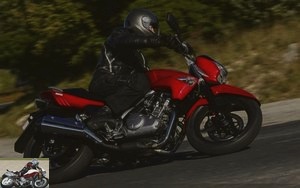
Part-cycle
Although very classic, the part-cycle does not call for any particular reproach. The Inazuma is lively and safe, both in town and on the secondary network. Playful, reassuring, she fulfills her contract. Its well-tuned suspensions limit mass transfers, despite a flexible tared fork. It remains to be seen their evolution over time.
Braking
Perfectly suited to her abilities, the Nissin equipment slows down without forcing the little Japanese girl. Its progressiveness remains an appreciable asset on a daily basis and on slippery roads..
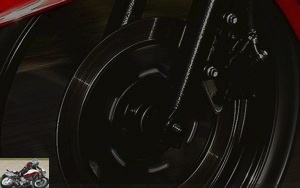
Comfort / Duo
Mimicking more powerful machines, the Inazuma is hardly far from it. The seat pleasantly receives the crew, who benefit from pleasant ergonomics. The entry-level damping does not work miracles, struggling to withstand significant compressions. However, small shocks and defects in bitumen are generally well filtered..
Able to take a passenger effortlessly into town, we can hardly count on the same dynamic duo on the road. Able to overcome this stain, the Suzuki will not excel there.
Consumption
Despite sustained use, only 3.3 liters of unleaded for 100 km traveled were sufficient for the 250 roadster. An even lower consumption is possible, giving a range of between 350 and 400 km for 13.3 liters on board. A point comparable with lighter competitors.
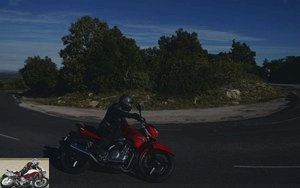
Conclusion
Dynamic, rewarding, the Suzuki 250 Inazuma gives much more than its displacement suggests. Its generous line gives the impression of piloting a larger machine. Particularly neat, its aesthetic roadster character will deceive more than one and the place ideally against competitors with a more sporty image. Thus, the Honda CBR 250, Kawasaki Ninja 300 and KTM 200 seem far removed from the versatile Inazuma. In fact, the differences in use are less. Displayed respectively at € 3,990, € 4,999 and € 4,290, these small cars see the newcomer offering a price of € 3,990. Less efficient than the Ninja and less fun than the Austrian, the Inazuma opposes its statutory plastic.
We will also wonder about the positioning of these machines against a Honda NC 700 S at 5,490 €. Economic utility, the latter still offers the approval of a high-displacement machine. But its engine dedicated to the lowest consumption is hardly encouraging…. Will the future pass through these sparkling "little" motorcycles? A risky bet in the land of the mid-capacity roadster.
Strong points
- Smooth and lively motorization
- Agile cycle part
- Consumption
- Neat image
Weak points
- Suspensions
- Weight
Colors
- Pearl Nebular Black
- Candy Cardinal Red
Competitors:
Datasheet
Related articles
-
driving school 4 cylinders of 999 cm3, 95 hp, 92 Nm, 214 kg full made, 19 liter tank Of its maxi sport roadster GSX-S 1000, Suzuki offers a 950 version…
-
Authentic avant-garde 4 cylinders of 999 cm3, 152 hp, 106 Nm, 214 kg full made, 19 liter tank 45 years old ! The GSX saga began in 1976 with the GS 750,…
-
Single cylinder, 4-stroke, 124.4 cm3, 15 hp at 10,000 rpm, 11.5 Nm at 8,000 rpm, 134 kilos, € 4,599 A little sportswoman who worthily represents the…
-
197 hp at 9,500 rpm, 155 Nm at 7,200 rpm, 3 engine maps, 300 km / h, € 15,499 Cut for speed, does the myth stand up to the ravages of time? ? Thursday 11…
-
The Asian intruder in Power Cruisers Rather renowned for its sports machines and roadsters, Suzuki has also been offering custom models for many years….
-
Suzuki GSR 750 motorcycle test
The way of the Samurai Following an almost Darwinian principle, motorcycle models are constantly evolving and by period. Thus, the era of the 600cc…
-
The Burgman is the line of Suzuki scooters, available in 125, 200, 400 and 650 cm3. The 400 version is aesthetically very close to the 125 version, and a…
-
Energy influx Modernized and more powerful, the Suzuki DL1000 V-Strom is making a remarkable comeback in the highly competitive and popular segment of GT…
-
Single cylinder, 4-stroke, 124 cc, 15 hp, 133 kilos, from € 4,099 A stylish and sporty little roadster for young people or beginners The roadsters being…
-
Quiet strength 4 cylinders in line of 749 cm3, 95 hp (flanged to 47.5 hp), 62.9 Nm, 213 kg full made, 8,599 euros Born GSR in 2011, the Suzuki midsize…
THANKS to the staff of the Rep. bikers.
European motorcycles "took the upper hand" over Japanese motorcycles. . The Speed Triple 1050 or the Street Triple 675 … the R if possible; are 02 MAGNIFICENT motorcycles; finishing up, successful design and the mill: "enchanting", enjoyable …
A + … VVV … zouc.
just a note: the new speed is 135hp.

It loses 29 hp with the bridle.
otherwise, very good article.
> Toffee
hey you…
Corrected.
I perfectly find the behavior of my street in this test. It is noted an improvement of the gearbox with synthetic oil (mineral oil during break-in)
and a relaxation of the rear shock after the first 2000 kilometers. Comfort is still limited. In some books we could read: "comfortable motorcycle for this style of motorcycle" to translate as "comfort worthy of a German car" or "stewed back abstain".
There are many "sissies" which roll up hard and which consume less than 6L.
It is less enjoyable than the ON / OFF allowing to pull on the engine and the brakes, but the hourly average is the same and the portfolio less lightened. (gasoline, tires, pads)
Personal on circuit I am at 7L5 and mixed at 5L7.
The consumptions announced by the on-board computer are fanciful.
Yeah, finally, as much the 675 is bluffing as the 1050 restrained !!!! it’s really m ….. that.
Nothing in the bag, it regulates at 6000 trs … blah. While the 955, mm in 100 hp, was simply incredible….
So to avoid the temptation of unbridling it will be 1100 evo and there it is magic in the bar!!!
"The English have landed, it will bleed" It is very good …. It is a call to bikers??
Nice little toy or gift for Christmas from Triumph, can we still hear the hissing of the crankcase gears a little too much on this model??
yeah … I know, it wasn’t very thin.
Thanks for this test !
Indeed it risks hurting !
It is beautiful, powerful, healthy … as long as the reliability follows what one can think of by reading the interval of revisions, it could be almost perfect! : D
8000 € the "people’s" motorcycle, excluding options of course, which are no longer a bonus but basic equipment withdrawn.
It’s more and more dreaming, strongly the Trail version а 12000 € with the 40 ‘screen as standard and the wheels supplied in the "rouling" pack.